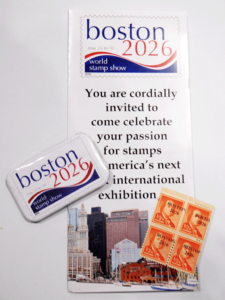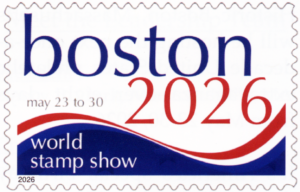 Even though the dust hasn’t settled yet on the 2016 U.S. international stamp show, work is under way on the next one, Boston 2026.
Even though the dust hasn’t settled yet on the 2016 U.S. international stamp show, work is under way on the next one, Boston 2026.
Actually, some of the planning began in 2007, a year after the previous “international,” Washington 2006.
Each country is allowed by the International Federation of Philately, to host one “international” a decade. For the U.S., these are held in years ending in 6, except for years that end in 47 and 97 — because the U.S. issued its first stamps in 1847. Thus, the U.S. show in the 1990s was Pacific 97.
One of the first steps is to get the approval of the national stamp collecting federation, which in the U.S. is the American Philatelic Society.
“We were ‘anointed’ last year,” Boston 2026 president Nancy Clark tells The Virtual Stamp Club.
“It’s going to be a fabulous gathering in Beantown,” Clark added. ”There are always invited special rarities that are superb and that you don’t see any other time.”
But it won’t just be world-class exhibits.
“You’re going to have post offices from around the world, you’re going to have dealers from around the world,” she said in the VSC interview.
Clark and others are also looking forward to seeing old friends from other countries.
“As my daughter likes to say, ‘You’re going to a reunion.’
Will there be anything at the show for more casual collectors or even the general public?
“Absolutely, Lloyd, you know my reputation is built on some substance,” Clark replied. “There will be meat and potatoes philately going on in an area that is for beginners.”
According to Yamil H. Kouri, Jr., a member of the Boston 2026 committee, noted that Boston is the fifth largest metro area in the United States. About 22 percent of the U.S. population and 52 percent of Canada’s live within a one-day drive of Boston.
The theme of the show will be the 250th anniversary of the United States.
The show will be held at the Boston Convention Center in the Seaport district.
 “We’re going to be taking up the entire convention center,” Clark told The VSC. “It’s downtown, it’s right next to the main post office area where they do all the sorting and stuff, straight on the Silver Line [of the rail transit system] right out of the airport, it’s very easy to get to, and you’re within walking distance of anything downtown.”
“We’re going to be taking up the entire convention center,” Clark told The VSC. “It’s downtown, it’s right next to the main post office area where they do all the sorting and stuff, straight on the Silver Line [of the rail transit system] right out of the airport, it’s very easy to get to, and you’re within walking distance of anything downtown.”
The Boston 2026 committee is strongly allied with the Cardinal Spellman Philatelic Museum in Weston, MA, and the Northeast Federation of Stamp Clubs, which puts on Philatelic Show each year in Boxboro, MA. The latter has already paid the $10,000 down payment to reserve the convention center.
The Westin Boston Waterfront Hotel is attached to the convention center, but in 2019, a second attached hotel should be completed and open. The Committee also promises two nearby moderately-priced hotels.
Asked at an open meeting during World Stamp Show-New York 2016 about the Boston show’s logo (shown above), publicity chair Tom Fortunato — who handled the same job for Washington 2006 and WSS-NY16 — replied that logos for “internationals” often change during the long gestation period. Boston 2026 executive director Mark Butterline pointed out that there is no standout icon for Boston, unlike New York’s Statue of Liberty or Washington’s Capitol dome.
Asked at the meeting about Boston 2026’s “vision,” Kouri replied, “different than the New York Show.”




I would think that the USS Constitution would be a standout icon.
Being that it’s celebrating the 250th anniversary of the United States, perhaps a Bunker Hill Monument type design resembling Scott 1034 would work?
Planning for Boston is fine, but I am curious about the attendance figure for the 2016 NYC show. That has never been announced, apparently.
I will see some of the organizers this weekend in Bellefonte at APS Headquarters and I’ll try to ask, but I don’t guarantee I’ll get an answer!
Linn’s Stamp News reports organizers say there were 23,017 unique visitors to World Stamp Show-New York 2016. This is based on registrations; no one was allowed onto the show without registering and receiving (wearing) a badge. Previous big shows counted a person each time he or she entered the show floor, which meant if that person went out for lunch and came back, that was “two people.”